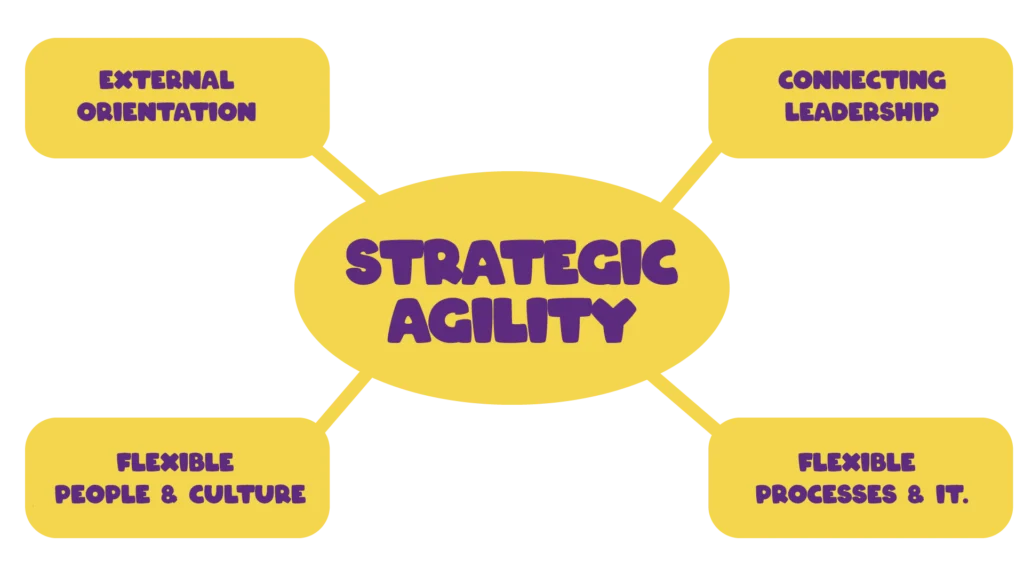In an era marked by rapid technological shifts, globalization, and discerning customers, markets have become more dynamic, complex, and unpredictable than ever before. Companies can only survive these growing uncertainties by maintaining high levels of flexibility and agility.

Think of Your Strategy as a Garden
Think of your strategy as a garden that you maintain. Initially, you plant seeds (strategic plans) and provide them with water and nutrients (resources and competencies). However, a garden doesn’t grow by itself; weeds (problems) appear, and you must regularly prune (make adjustments) to ensure that the plants keep blooming. By consistently caring for your garden, you ensure that it remains healthy and bears fruit. Similarly, a business strategy requires ongoing care and adjustments for growth and success.
Historical Agility Developments
Although the term Agile is widely used today, the concept behind it is not new. In the 1950s, we saw product agility, followed by production agility in the 1980s. The 1990s brought process agility, and the 2000s saw organizational agility. Now we are in the phase of strategic agility. An agile strategy is seen by many companies as the ultimate competitive weapon. This involves not just an agile organization but also a flexible strategy development process and the swift and smart implementation of this strategy.
Flexibility as a Basis for Success
An agile strategy is crucial in the modern business environment. Companies like Spark and Roche demonstrate that defining a unique agile culture and making personal connections with employees are essential for success. Spark, a New Zealand digital service provider, transformed its entire organization to an agile model within a year, starting with defining ‘from-to’ behavioral changes to embed the agile culture. Roche, a biotechnology company, focused on personal transformation by inviting leaders to participate in a four-day program to learn agile leadership.
Continuous Adaptation and Improvement
Strategic agility is not just about implementing a strategy but continuous adaptation and improvement, supported by a culture of reflection and feedback. Research from ScienceDirect shows that reflection without feedback is ineffective and vice versa. Companies must combine both strategies for maximum learning effect. Reflection helps employees analyze and learn from their experiences, while feedback helps them adapt to changing circumstances.
In conclusion, strategic agility requires a flexible approach, continuous adaptation, and a culture of collaboration and learning. By applying these principles, companies can better navigate an unpredictable market and strengthen their competitive position.
Key Lessons for an Agile Strategy
1. Multiple Value Creation Instead of Profit Maximization
In the modern economy, companies are shifting their focus from pure profit maximization to creating multiple values. This means building a business case from a shared perspective, considering the interests of diverse stakeholders like customers, employees, and the broader community. This approach emphasizes that serving a common interest ultimately leads to a stronger and more sustainable business case. Instead of solely aiming for cost reduction, companies focus on generating revenues based on shared values.
The concept of value creation goes beyond financial profit: it also encompasses social and ecological benefits. By investing in sustainability and social responsibility, companies can improve their reputation and build long-term relationships with their stakeholders. Innovation plays a crucial role here, as companies must continually respond to changing market conditions and customer needs. By embracing new technologies and processes, companies can offer unique products and services that create value for their customers and contribute to a better world.
2. Extremely Market and Customer-Oriented
A successful strategy to survive in the current economy is being customer-obsessed. Agile business and customer-driven approaches, where the customer acts as a business partner, go hand in hand. This approach brings advantages to both sides. Engaged customers do much more than just purchases; they act as ambassadors for your organization, provide customer service in online communities, and offer valuable information, ideas, and insights. In some cases, customers even become co-producers of your products or services.
Companies that are extremely customer-oriented build strong relationships with their customers through frequent interactions and continuous feedback. This customer-centric approach allows companies to quickly respond to changing customer needs and market conditions, leading to higher customer satisfaction and loyalty. An agile marketing strategy, for example, uses short iterations and experiments to continually deliver value to customers. This ensures flexibility and adaptability, allowing companies to strengthen their competitive position and achieve sustainable growth.
3. Focused on Both Long and Short Term
A forward-rolling strategy combines an inspiring vision and long-term goals with SMART short-term improvement actions. This approach ensures that your organization can be successful both in the long and short term. By using rolling wave planning, teams can work in smaller, more manageable time periods. This helps in adapting to changes and achieving short-term goals while maintaining the long-term vision.
Rolling wave planning, a technique from the agile project management methodology, allows teams to focus on short-term objectives with the broader vision in mind. This process involves iteratively planning and executing projects in successive “waves” or phases. Each wave is carefully planned based on the most recent information and project requirements. This increases flexibility and allows for quick responses to new insights or changing conditions, which is essential in a dynamic market.
4. Connecting Leadership at All Levels
As a leader of an agile organization, you connect the turbulent environment with your organization and employees. At the organizational level, you set clear goals that inspire and guide team members. It is crucial to break down internal silos that hinder collaboration. When teams work in isolation, it leads to inefficiency, a lack of innovation, and wasted resources. By breaking down silos, you promote horizontal collaboration and create a culture of open communication and shared goals.
On an individual level, it is important to align everyone in the same direction by developing a culture where employees feel safe to ask questions and share ideas without fear of negative consequences. Developing cultural brokers within your company can help bridge differences and stimulate collaboration. These employees excel in connecting people from different departments and promoting the exchange of knowledge and expertise. This increases engagement and trust within your team, which is essential for an agile work environment.
By applying connecting leadership and breaking down silos within the organization, you can create a dynamic and resilient organization better able to respond to changes and seize new opportunities.
5. Quick Decision-Making and Execution
Speed and timing are crucial success factors in today’s dynamic market environment. The lifecycle of products and companies is becoming shorter due to the rapid development of technologies and societal changes. These factors make it essential for organizations to make quick decisions and execute them efficiently. Organizations that are agile and integrate speed into their strategic execution processes have a significant competitive advantage.
There are roughly two innovation strategies: you can be a first mover who brings new products or services to the market first, or a smart follower who quickly reacts to market developments. Both strategies require a reduced time-to-market. First movers benefit from pioneer advantage by capturing market share first, while smart followers quickly learn from the pioneers’ experiences and offer improved versions of products. In both scenarios, the timing of your ideas, products, and innovations is crucial. This means that organizations must be flexible and quick to adapt based on market and customer insights.
Successful organizations implement several best practices to promote speed and agility. First, they plan more frequently and proactively, allowing them to quickly make adjustments in response to changes. Second, they broadly apply lean and agile methodologies, streamlining strategic execution and leading to faster, higher-quality results. Finally, they use technology to inform decision-making, with access to real-time, accurate data and analyses crucial for making complex decisions and adjustments.
By embracing these practices, organizations can shorten their time to market while improving the quality of their products and services, positioning themselves better to survive and grow in a rapidly changing world.
6. Result-Driven Culture
A result-driven culture within an agile strategy is about mobilizing the right people at the right time to tackle strategic projects and improvement actions. This can be more challenging than it seems. Using cross-functional teams, both existing and newly formed, organizations can achieve better results.
New organizational forms, such as squads, work incrementally according to agile principles like Scrum, Sprints, and Kanban. These high-performance working methods create focus and a sense of urgency within teams. This is essential because a result-driven culture not only sets goals but also achieves measurable results. According to McKinsey, successful agile organizations include a network of teams within a people-centered culture that enables rapid decision-making and learning cycles. This is supported by technology and a common goal that co-creates value for all stakeholders.
Realizing a result-driven culture also requires a shift in the mindset of leaders and employees. Leaders must act as visionaries and coaches, empowering and developing teams. This helps teams work autonomously and take responsibility for their results. Additionally, an agile culture plays a crucial role in promoting continuous improvement and innovation. Through iterative processes and rapid feedback loops, teams can constantly learn and adapt, leading to higher efficiency and better performance.
In short, a result-driven culture within an agile strategy creates a dynamic and responsive work environment where teams can effectively collaborate and deliver excellent results.
7. Flat (Network) Organization
An agile organization requires a completely different culture and mindset. Instead of rigid hierarchies and fixed functions, we see the rise of flat network structures. These structures promote flexibility and rapid adaptation through dynamic teams that can be reconfigured based on needs. This allows employees and teams to be quickly assigned to different projects, business units, and tasks. This means that lines of communication are short, and communication is direct, which is essential for quick decision-making and responsiveness.
Within a flat network organization, roles and tasks are fluid and can change depending on the situation. There is little hierarchy, meaning fewer management layers and more autonomy for teams. This promotes a culture where employees take more responsibility and can act quickly. Successful agile organizations form a network of teams within a people-centered culture, enabling rapid learning cycles and decision-making processes. This provides not only flexibility but also a powerful common goal that creates value for all stakeholders.
The benefits of a flat network organization are numerous. Employees feel more involved and empowered because they have the freedom to innovate and collaborate without bureaucratic barriers. This promotes creativity and efficiency, which is crucial in a rapidly changing market. Moreover, organizations can respond more quickly to changes in the market and customer needs, giving them a competitive edge. In short, implementing a flat network structure within an agile strategy helps organizations become more agile, innovative, and resilient.
8. Flexible Business Model
Agile companies can quickly adapt their business model as conditions change. A flexible business model allows companies to quickly respond to market changes and customer needs. Developing, marketing, and servicing products and services increasingly happens in collaboration with customers, suppliers, and other stakeholders. This creates an ecosystem where everyone contributes to innovation and improvement.
The decision to do something yourself, do it together, or outsource it depends on various factors like your competitive strategy, focus, flexibility, quality, and cost. Companies like Barclays and Lonely Planet have shown that using a flexible business model helps improve productivity and customer satisfaction. By using technologies like Amazon Web Services, companies can quickly adjust and adapt their infrastructure to changing market needs.
A flexible business model ensures that companies are not stuck in rigid structures and processes. This type of model uses agile methodologies to continuously evaluate and improve. This allows organizations to work more efficiently, save costs, and innovate faster. Companies like Moonpig and Fitbit have shown that focusing on flexibility and collaboration leads to better results and higher employee satisfaction. In short, a flexible business model is essential for the success of an agile organization in the modern market.
9. Flexible Work Organization
In a flexible work organization, tasks, responsibilities, and authorities are delegated to small, result-oriented, self-organizing teams. These teams are multidisciplinary and can quickly change composition as circumstances require. This requires flexible employees who are willing and able to take on diverse roles and tasks.
Successful agile organizations, such as ING and Spotify, have proven that working with self-organizing teams leads to higher productivity and innovation. These teams operate within a network structure, allowing them to make quick decisions and adapt to changing circumstances. The goal is to create a culture where employees feel empowered and take responsibility for their work. This leads to higher engagement and satisfaction among employees, which is essential for an agile organization.
A flexible work organization also uses modern technologies and methods to improve collaboration and communication. Tools like Scrum and Kanban help teams organize and prioritize their work, while platforms like Slack and Microsoft Teams enable real-time communication and collaboration. This allows teams to quickly adapt to new challenges and opportunities. Flexible work organizations are thus not only more efficient but also better able to innovate and create value for their customers and stakeholders.
10. Flexible ‘Lean and Mean’ Processes and ICT
Strategic agility means using flexible concepts and tools like Lean, Six Sigma, process and ICT frameworks, standardization, modularization, cloud computing, agile software development, and strategic agility systems like Triggre. These methods help organizations work more efficiently and quickly respond to changing market conditions.
Lean and Six Sigma are popular methods to optimize processes and reduce waste. By combining these techniques with agile software development, teams can deliver high-quality products faster. Cloud computing also offers flexibility by scaling IT resources up or down as needed, which is cost-effective and efficient. Platforms like Amazon Web Services and Microsoft Azure allow for quick responses to changes and the integration of new technologies.
Modularization and standardization are essential parts of a flexible ICT strategy. These techniques enable organizations to make components reusable and implement changes quickly without redesigning the entire system. This not only speeds up development but also ensures that teams can work independently while maintaining consistency. Using strategic agility systems like Triggre helps streamline processes and improve overall business flexibility. This prepares organizations for future challenges and allows them to quickly seize new opportunities.
11. Openness, Transparency, and Maximum Availability of Information
Companies that invest in customer-driven open innovation and actively gather and share knowledge are more innovative and successful than companies that do less. Open innovation involves using both internal and external ideas and pathways to the market. This not only increases innovation capacity but also promotes collaboration and knowledge sharing, resulting in faster and better solutions.
A key aspect of open innovation is co-creation, where companies collaborate with customers or users to generate new ideas and gather feedback. This ensures that products and services better meet customer needs. Additionally, sharing knowledge and resources with external partners, such as universities or start-ups, can shorten development time and reduce costs. This type of collaboration can also create new revenue streams by developing ideas that do not fit within the current business strategy externally.
Transparency and maximum availability of information play a crucial role in the success of open innovation. By fostering an open culture where information is freely shared, companies can respond more quickly to changes and better capitalize on new opportunities. Collaboration forms like crowdsourcing and user-generated content help gather a wide range of ideas and select the most promising concepts. This leads to a more dynamic and competitive organization that can continuously improve and innovate.
12. Learning Organization: Evolutionary, Incremental, and Continuous Improvement
The line between education and job is increasingly blurring, making learning and working one whole. Lifelong learning is essential for both managers and employees, especially with the growing emphasis on 21st-century skills. A culture of lifelong learning not only promotes personal development but also ensures that employees feel valued and perform better. This ultimately leads to a more productive and innovative organization.
Knowledge management is about optimally unlocking key knowledge and maximally connecting key specialists. By creating an environment where employees can continuously develop new skills, the organization remains competitive and agile. This can be achieved by offering diverse learning programs and encouraging the exchange of knowledge and experiences among employees. Investing in learning and development opportunities ensures that employees feel engaged and reduces turnover, saving costs in the long run and strengthening the company culture.
Ongoing Review and Adjustment
A good strategy is a realistic strategy. It must be achievable and align with the organization’s competencies, resources, and culture. Additionally, a good strategy must be simple. You should be able to explain the strategy easily to get your people excited, whether they are managers, employees, or shareholders.
However, a good strategy must also be dynamic. No strategy is indefinitely sustainable. Therefore, it is essential to continuously review and adjust your strategy. Regular evaluation of your business strategy ensures that you never stand still. Your plans remain relevant and effective, aligning with the current priorities of your vision and audience. This continuous adjustment allows you to adapt to changing circumstances while staying true to your goals.
You must be open to adjustments throughout the year, not just at the beginning. Interim or even quarterly reviews show the progress of your goals and allow for necessary adjustments. A mid-year strategy review helps keep your business flexible. By creating a fixed schedule for strategic reviews, you can check each quarter if you are on track to achieve your goals. It is important to review your business strategy when significant market changes occur, such as shifts in consumer sentiment. This flexibility allows you to respond and adjust. In short, to realize an agile organization, you must be willing to regularly review and adjust your strategy. This is not a process that happens overnight but a continuous effort to keep your business agile and competitive.

